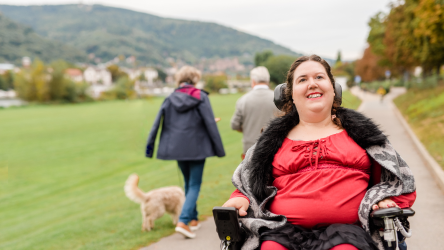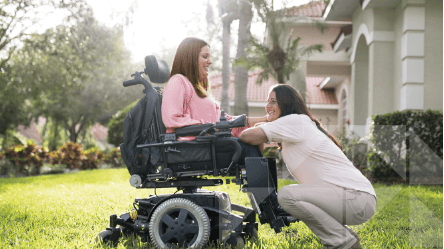Diagnosis and Testing
Testing for a SMN1 gene mutation1
The SMN gene deletion test may be ordered by a paediatrician
or neurologist and is performed in pathology labs. It can generally take up to a month to receive the results.
A SMA diagnosis may take
some medical detective work
Because the signs and symptoms of SMA are not highly specific and may occur at different ages and with different severity, an initial diagnosis can be delayed.
To help narrow down the diagnosis, healthcare providers may use other diagnostic tests to rule out other forms of muscle disease.
Diagnosis and Testing
Ruling out other forms of muscle disease
Some muscle diseases can look like SMA, and vice versa. Additional diagnostic tests may help accurately identify other forms of muscle disease.
Speak to your doctor for more information about what tests may be suitable for you or your child.
Additional genetic testing
If the SMN gene deletion test is negative, additional genetic testing that looks at other genes can help confirm a diagnosis.
Creatine kinase blood test
A blood test to measure the level of creatine kinase, a molecule produced by the breakdown of muscle.
Electromyography
A diagnostic technique that measures electrical activity in the muscle.
Diagnosis and Testing
A typical diagnosis and treatment journey.
1
First diagnosis
Infantile onset (<6 months) or later onset (≥7 months).
2
Paediatrician consultation
Child shows symptoms. More than one consultation may be needed before referral to a relevant specialist.
3
Paediatric neurologist consultation
Performs electromyography, creatine kinase, or genetic testing.
4
Genetic test confirms SMA
Infantile onset (<6 months) or later onset (≥7 months).
5
SMA multidisciplinary care-team meeting
Review and discuss diagnosis and supportive care options.
6
Ongoing SMA multidisciplinary care-team meetings
For assessment of progression by a physiotherapist and adjusted of care plan by our doctor.
7
Periodic paediatrician consultations
For immunisations, minor infections, and other non-SMA-related needs.
1
Symptoms noticed
Experiences symptoms (e.g. muscle weakness)
2
General Practitioner consultation
Physical examination for signs and symptoms. More than one consultation may be needed before referral to a relevant specialist
3
Neurologist consultation
Performs electromyography, and creatine kinase and/or genetic testing
4
Genetic testing confirms SMA
Diagnoses of SMA in adulthood are likely
Type 3 or 4
5
SMA multidisciplinary care team
Care teams are assembled based on individual health needs
6
Periodic consultations
Ongoing engagement with the SMA care team ensures optimal management of SMA
Delays in diagnosis can be common, which may potentially impact your care options.1 Regulator motor function assessments are also important.
Diagnosis and Testing
SMA Questions
These commonly asked questions provide additional information to understand diagnosis and testing for SMA. They are also good starter topics for discussions with your doctor.
Yes, babies and infants can have SMA. These individuals can be pre-symptomatic picked up with newborn screening or present with symptoms. Symptoms can include muscle weakness, inability to hold head up or control head movements, or hypotonia (low muscle tone that may make a baby appear "floppy").1
If you are concerned about your child’s development, please speak to your doctor or nurse as soon as possible as this may lead to an earlier diagnosis of SMA, which can improve outcomes.
1. D'Amico A et al. Spinal muscular atrophy. Orphanet J Rare Dis. 2011;6:71.
Adult SMA develops later in life, around 30 years of age.1 This is the mildest type of SMA and individuals may experience some muscle weakness but keep the ability to walk.2
Children who are diagnosed with SMA and grow into adulthood will experience a different care journey than individuals who are diagnosed as adults.
- Farrar MA et al. Emerging therapies and challenges in spinal muscular atrophy. Ann Neurol. 2017;81(3):355-368.
- Prior TW et al. Spinal muscular atrophy. NCBI Bookshelf Website. Available at https://www.ncbi.nlm.nih.gov/books/NBK1352/ (Accessed June 2025).
SMA is not a curable condition yet. However, some therapies may be able to slow the progress of SMA, and different types of care (for breathing and bone health, for example) can help with motor function.
- Mercuri E et al. Diagnosis and management of spinal muscular atrophy: Part 1: Recommendations for diagnosis, rehabilitation, orthopedic and nutritional care. Neuromuscul Disord. 2018;28(2):103-115.
- Finkel RS et al. Diagnosis and management of spinal muscular atrophy: Part 2: Pulmonary and acute care; medications, supplements and immunizations; other organ systems; and ethics. Neuromuscul Disord. 2018;28(3):197-207.
SMA is diagnosed by a paediatric neurologist in children, and an adult neurologist in adults. Whether an individual with SMA will need to see additional specialists depends on the type and level of care they may require. Individuals with SMA may have a multidisciplinary care team that includes, for example: a neurologist, a respiratory specialist, a dietitian and/or a nutritionist, a physiotherapist, and an orthopaedic surgeon.1,2
- Mercuri E et al. Diagnosis and management of spinal muscular atrophy: Part 1: Recommendations for diagnosis, rehabilitation, orthopedic and nutritional care. Neuromuscul Disord. 2018;28(2):103-115.
- Finkel RS et al. Diagnosis and management of spinal muscular atrophy: Part 2: Pulmonary and acute care; medications, supplements and immunizations; other organ systems; and ethics. Neuromuscul Disord. 2018;28(3):197-207.
References:
1. Prior TW et al, Spinal Muscular Atrophy [Updated 2 Dec 2020]. Available from: Available from: https://www.ncbi.nlm.nih.gov/books/NBK1352/ Accessed June 2025.
2. Darras B. Pediatr Clin N Am 2015; 62: 743–66.
3. Wang CH et al. J Child Neurol 2007; 22: 1027–49..
4. Mercuri E et al. Neuromuscul Disord 2018;28(2):103-115.
You may also be interested in
SMA is a genetic condition that predominantly affects children, but can also affect adults. Symptoms can vary by age and severity.
Every individual with SMA may experience symptoms and the effects of SMA differently. Care options are tailored to the needs of each individual.








































